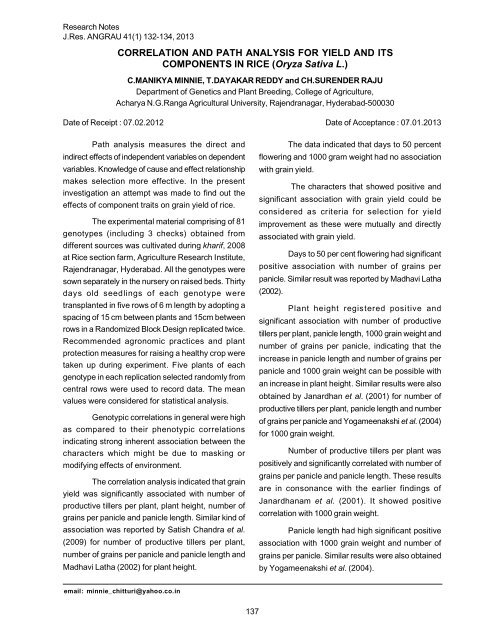The Journal of Research ANGRAU
Contents of 41(1) 2013 - acharya ng ranga agricultural university
Contents of 41(1) 2013 - acharya ng ranga agricultural university
Create successful ePaper yourself
Turn your PDF publications into a flip-book with our unique Google optimized e-Paper software.
<strong>Research</strong> Notes<br />
J.Res. <strong>ANGRAU</strong> 41(1) 132-134, 2013<br />
CORRELATION AND PATH ANALYSIS FOR YIELD AND ITS<br />
COMPONENTS IN RICE (Oryza Sativa L.)<br />
C.MANIKYA MINNIE, T.DAYAKAR REDDY and CH.SURENDER RAJU<br />
Department <strong>of</strong> Genetics and Plant Breeding, College <strong>of</strong> Agriculture,<br />
Acharya N.G.Ranga Agricultural University, Rajendranagar, Hyderabad-500030<br />
Date <strong>of</strong> Receipt : 07.02.2012 Date <strong>of</strong> Acceptance : 07.01.2013<br />
Path analysis measures the direct and<br />
indirect effects <strong>of</strong> independent variables on dependent<br />
variables. Knowledge <strong>of</strong> cause and effect relationship<br />
makes selection more effective. In the present<br />
investigation an attempt was made to find out the<br />
effects <strong>of</strong> component traits on grain yield <strong>of</strong> rice.<br />
<strong>The</strong> experimental material comprising <strong>of</strong> 81<br />
genotypes (including 3 checks) obtained from<br />
different sources was cultivated during kharif, 2008<br />
at Rice section farm, Agriculture <strong>Research</strong> Institute,<br />
Rajendranagar, Hyderabad. All the genotypes were<br />
sown separately in the nursery on raised beds. Thirty<br />
days old seedlings <strong>of</strong> each genotype were<br />
transplanted in five rows <strong>of</strong> 6 m length by adopting a<br />
spacing <strong>of</strong> 15 cm between plants and 15cm between<br />
rows in a Randomized Block Design replicated twice.<br />
Recommended agronomic practices and plant<br />
protection measures for raising a healthy crop were<br />
taken up during experiment. Five plants <strong>of</strong> each<br />
genotype in each replication selected randomly from<br />
central rows were used to record data. <strong>The</strong> mean<br />
values were considered for statistical analysis.<br />
Genotypic correlations in general were high<br />
as compared to their phenotypic correlations<br />
indicating strong inherent association between the<br />
characters which might be due to masking or<br />
modifying effects <strong>of</strong> environment.<br />
<strong>The</strong> correlation analysis indicated that grain<br />
yield was significantly associated with number <strong>of</strong><br />
productive tillers per plant, plant height, number <strong>of</strong><br />
grains per panicle and panicle length. Similar kind <strong>of</strong><br />
association was reported by Satish Chandra et al.<br />
(2009) for number <strong>of</strong> productive tillers per plant,<br />
number <strong>of</strong> grains per panicle and panicle length and<br />
Madhavi Latha (2002) for plant height.<br />
<strong>The</strong> data indicated that days to 50 percent<br />
flowering and 1000 gram weight had no association<br />
with grain yield.<br />
<strong>The</strong> characters that showed positive and<br />
significant association with grain yield could be<br />
considered as criteria for selection for yield<br />
improvement as these were mutually and directly<br />
associated with grain yield.<br />
Days to 50 per cent flowering had significant<br />
positive association with number <strong>of</strong> grains per<br />
panicle. Similar result was reported by Madhavi Latha<br />
(2002).<br />
Plant height registered positive and<br />
significant association with number <strong>of</strong> productive<br />
tillers per plant, panicle length, 1000 grain weight and<br />
number <strong>of</strong> grains per panicle, indicating that the<br />
increase in panicle length and number <strong>of</strong> grains per<br />
panicle and 1000 grain weight can be possible with<br />
an increase in plant height. Similar results were also<br />
obtained by Janardhan et al. (2001) for number <strong>of</strong><br />
productive tillers per plant, panicle length and number<br />
<strong>of</strong> grains per panicle and Yogameenakshi et al. (2004)<br />
for 1000 grain weight.<br />
Number <strong>of</strong> productive tillers per plant was<br />
positively and significantly correlated with number <strong>of</strong><br />
grains per panicle and panicle length. <strong>The</strong>se results<br />
are in consonance with the earlier findings <strong>of</strong><br />
Janardhanam et al. (2001). It showed positive<br />
correlation with 1000 grain weight.<br />
Panicle length had high significant positive<br />
association with 1000 grain weight and number <strong>of</strong><br />
grains per panicle. Similar results were also obtained<br />
by Yogameenakshi et al. (2004).<br />
email: minnie_chitturi@yahoo.co.in<br />
137

















